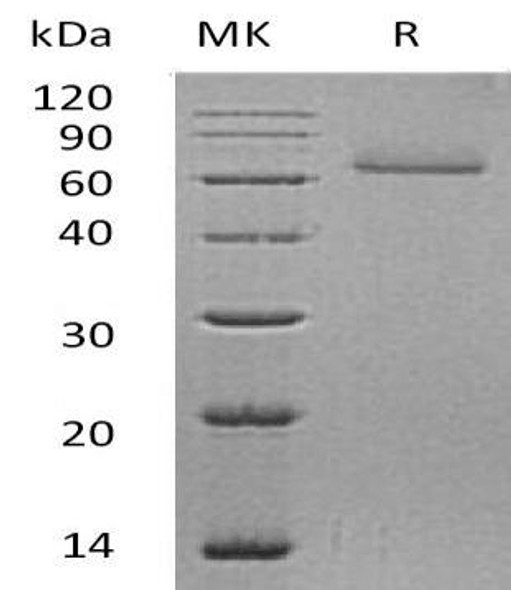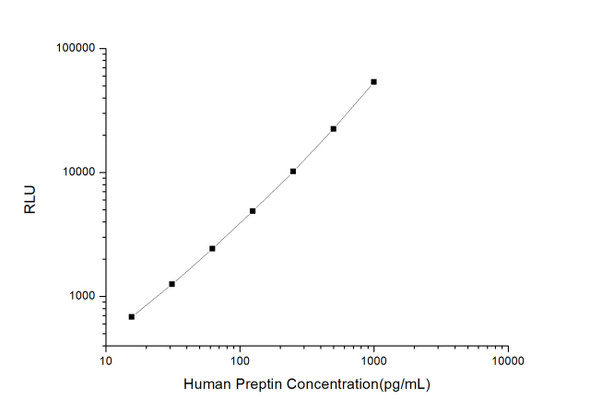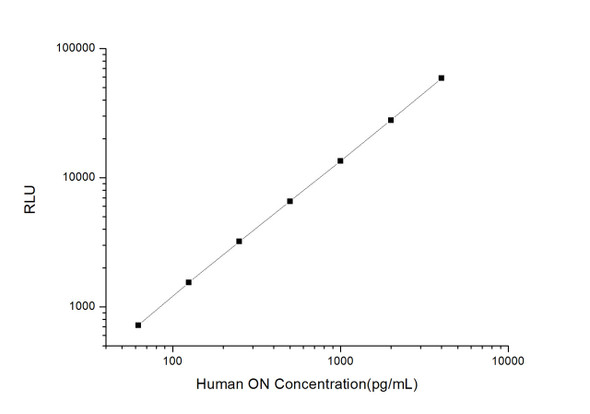Human Signal Transduction ELISA Kits
Human CDSN (Corneodesmosin) CLIA Kit (HUES00852)
- SKU:
- HUES00852
- Product Type:
- ELISA Kit
- ELISA Type:
- CLIA Kit
- Size:
- 96 Assays
- Sensitivity:
- 18.75pg/mL
- Range:
- 31.25-2000pg/mL
- ELISA Type:
- Sandwich
- Reactivity:
- Human
- Sample Type:
- Serum, plasma and other biological fluids
- Research Area:
- Signal Transduction
Description
| Assay type: | Sandwich |
| Format: | 96T |
| Assay time: | 4.5h |
| Reactivity: | Human |
| Detection method: | Chemiluminescence |
| Detection range: | 31.25-2000 pg/mL |
| Sensitivity: | 18.75 pg/mL |
| Sample volume: | 100µL |
| Sample type: | Serum, plasma and other biological fluids |
| Repeatability: | CV < 15% |
| Specificity: | This kit recognizes Human CDSN in samples. No significant cross-reactivity or interference between Human CDSN and analogues was observed. |
This kit uses Sandwich-CLIA as the method. The micro CLIA plate provided in this kit has been pre-coated with an antibody specific to Human CDSN. Standards or samples are added to the appropriate micro CLIA plate wells and combined with the specific antibody. Then a biotinylated detection antibody specific for Human CDSN and Avidin-Horseradish Peroxidase (HRP) conjugate are added to each micro plate well successively and incubated. Free components are washed away. The substrate solution is added to each well. Only those wells that contain Human CDSN, biotinylated detection antibody and Avidin-HRP conjugate will appear fluorescence. The Relative light unit (RLU) value is measured spectrophotometrically by the Chemiluminescence immunoassay analyzer. The RLU value is positively associated with the concentration of Human CDSN. The concentration of Human CDSN in the samples can be calculated by comparing the RLU of the samples to the standard curve.
| UniProt Protein Function: | CDSN: Important for the epidermal barrier integrity. Defects in CDSN are the cause of hypotrichosis type 2 (HYPT2). A condition characterized by the presence of less than the normal amount of hair. Affected individuals have normal hair in early childhood but experience progressive hair loss limited to the scalp beginning in the middle of the first decade and almost complete baldness by the third decade. Body hair, beard, eyebrows, axillary hair, teeth, and nails develop normally. Defects in CDSN are a cause of peeling skin syndrome (PSS); also known as peeling skin syndrome or deciduous skin or keratolysis exfoliativa congenita. A genodermatosis characterized by generalized, continuous shedding of the outer layers of the epidermis. Two main PSS subtypes have been suggested. Patients with non-inflammatory PSS (type A) manifest white scaling, with painless and easy removal of the skin, irritation when in contact with water, dust and sand, and no history of erythema, pruritis or atopy. Inflammatory PSS (type B) is associated with generalized erythema, pruritus and atopy. It is an ichthyosiform erythroderma characterized by lifelong patchy peeling of the entire skin with onset at birth or shortly after. Several patients have been reported with high IgE levels. CDNS mutations are responsible for generalized, inflammatory peeling skin syndrome type B (PubMed:20691404). |
| UniProt Protein Details: | Protein type:Cell adhesion; Secreted, signal peptide; Secreted Chromosomal Location of Human Ortholog: 6p21. 3 Cellular Component: desmosome; cornified envelope; intercellular junction Molecular Function:protein homodimerization activity Biological Process: keratinocyte differentiation; cell-cell adhesion; epidermis development; skin morphogenesis; cell adhesion Disease: Peeling Skin Syndrome 1; Hypotrichosis 2 |
| NCBI Summary: | This gene encodes a protein found in corneodesmosomes, which localize to human epidermis and other cornified squamous epithelia. During maturation of the cornified layers, the protein undergoes a series of cleavages, which are thought to be required for desquamation. The gene is located in the major histocompatibility complex (MHC) class I region on chromosome 6. [provided by RefSeq, Jul 2008] |
| UniProt Code: | Q15517 |
| NCBI GenInfo Identifier: | 67782356 |
| NCBI Gene ID: | 1041 |
| NCBI Accession: | NP_001255. 3 |
| UniProt Secondary Accession: | Q15517,O43509, Q5SQ85, Q5STD2, Q7LA70, Q7LA71, Q86Z04 Q8IZU4, Q8IZU5, Q8IZU6, B0S7V2, B0UYZ7, |
| UniProt Related Accession: | Q15517 |
| Molecular Weight: | 51,522 Da |
| NCBI Full Name: | corneodesmosin |
| NCBI Synonym Full Names: | corneodesmosin |
| NCBI Official Symbol: | CDSN |
| NCBI Official Synonym Symbols: | S; PSS; HTSS; HTSS1; D6S586E |
| NCBI Protein Information: | corneodesmosin; differentiated keratinocyte S protein |
| UniProt Protein Name: | Corneodesmosin |
| UniProt Synonym Protein Names: | S protein |
| Protein Family: | Corneodesmosin |
| UniProt Gene Name: | CDSN |
| UniProt Entry Name: | CDSN_HUMAN |
As the RLU values of the standard curve may vary according to the conditions of the actual assay performance (e. g. operator, pipetting technique, washing technique or temperature effects), the operator should establish a standard curve for each test. Typical standard curve and data is provided below for reference only.
| Concentration (pg/mL) | RLU | Average | Corrected |
| 2000 | 50671 60771 | 55721 | 55693 |
| 1000 | 22608 25340 | 23974 | 23946 |
| 500 | 11269 10795 | 11032 | 11004 |
| 250 | 4847 5741 | 5294 | 5266 |
| 125 | 2734 2482 | 2608 | 2580 |
| 62.5 | 1412 1210 | 1311 | 1283 |
| 31.25 | 634 714 | 674 | 646 |
| 0 | 27 29 | 28 | -- |
Precision
Intra-assay Precision (Precision within an assay): 3 samples with low, mid range and high level Human CDSN were tested 20 times on one plate, respectively.
Inter-assay Precision (Precision between assays): 3 samples with low, mid range and high level Human CDSN were tested on 3 different plates, 20 replicates in each plate.
| Intra-assay Precision | Inter-assay Precision | |||||
| Sample | 1 | 2 | 3 | 1 | 2 | 3 |
| n | 20 | 20 | 20 | 20 | 20 | 20 |
| Mean (pg/mL) | 92.52 | 224.11 | 744.86 | 97.36 | 232.05 | 739.82 |
| Standard deviation | 7.96 | 25.62 | 63.69 | 10.02 | 22.32 | 50.83 |
| C V (%) | 8.60 | 11.43 | 8.55 | 10.29 | 9.62 | 6.87 |
Recovery
The recovery of Human CDSN spiked at three different levels in samples throughout the range of the assay was evaluated in various matrices.
| Sample Type | Range (%) | Average Recovery (%) |
| Serum (n=5) | 88-103 | 94 |
| EDTA plasma (n=5) | 85-100 | 91 |
| Cell culture media (n=5) | 84-95 | 90 |
Linearity
Samples were spiked with high concentrations of Human CDSN and diluted with Reference Standard & Sample Diluent to produce samples with values within the range of the assay.
| Serum (n=5) | EDTA plasma (n=5) | Cell culture media (n=5) | ||
| 1:2 | Range (%) | 87-99 | 90-101 | 92-104 |
| Average (%) | 94 | 95 | 97 | |
| 1:4 | Range (%) | 94-105 | 97-115 | 90-104 |
| Average (%) | 99 | 105 | 95 | |
| 1:8 | Range (%) | 89-99 | 87-104 | 87-101 |
| Average (%) | 94 | 95 | 93 | |
| 1:16 | Range (%) | 85-99 | 98-112 | 102-117 |
| Average (%) | 90 | 105 | 109 |
An unopened kit can be stored at 4°C for 1 month. If the kit is not used within 1 month, store the items separately according to the following conditions once the kit is received.
| Item | Specifications | Storage |
| Micro CLIA Plate(Dismountable) | 8 wells ×12 strips | -20°C, 6 months |
| Reference Standard | 2 vials | |
| Concentrated Biotinylated Detection Ab (100×) | 1 vial, 120 µL | |
| Concentrated HRP Conjugate (100×) | 1 vial, 120 µL | -20°C(shading light), 6 months |
| Reference Standard & Sample Diluent | 1 vial, 20 mL | 4°C, 6 months |
| Biotinylated Detection Ab Diluent | 1 vial, 14 mL | |
| HRP Conjugate Diluent | 1 vial, 14 mL | |
| Concentrated Wash Buffer (25×) | 1 vial, 30 mL | |
| Substrate Reagent A | 1 vial, 5 mL | 4°C (shading light) |
| Substrate Reagent B | 1 vial, 5 mL | 4°C (shading light) |
| Plate Sealer | 5 pieces | |
| Product Description | 1 copy | |
| Certificate of Analysis | 1 copy |
- Set standard, test sample and control (zero) wells on the pre-coated plate and record theirpositions. It is recommended to measure each standard and sample in duplicate. Note: addall solutions to the bottom of the plate wells while avoiding contact with the well walls. Ensuresolutions do not foam when adding to the wells.
- Aliquot 100µl of standard solutions into the standard wells.
- Add 100µl of Sample / Standard dilution buffer into the control (zero) well.
- Add 100µl of properly diluted sample (serum, plasma, tissue homogenates and otherbiological fluids. ) into test sample wells.
- Cover the plate with the sealer provided in the kit and incubate for 90 min at 37°C.
- Aspirate the liquid from each well, do not wash. Immediately add 100µL of BiotinylatedDetection Ab working solution to each well. Cover the plate with a plate seal and gently mix. Incubate for 1 hour at 37°C.
- Aspirate or decant the solution from the plate and add 350µL of wash buffer to each welland incubate for 1-2 minutes at room temperature. Aspirate the solution from each well andclap the plate on absorbent filter paper to dry. Repeat this process 3 times. Note: a microplatewasher can be used in this step and other wash steps.
- Add 100µL of HRP Conjugate working solution to each well. Cover with a plate seal andincubate for 30 min at 37°C.
- Aspirate or decant the solution from each well. Repeat the wash process for five times asconducted in step 7.
- Add 100µL of Substrate mixture solution to each well. Cover with a new plate seal andincubate for no more than 5 min at 37°C. Protect the plate from light.
- Determine the RLU value of each well immediately.






